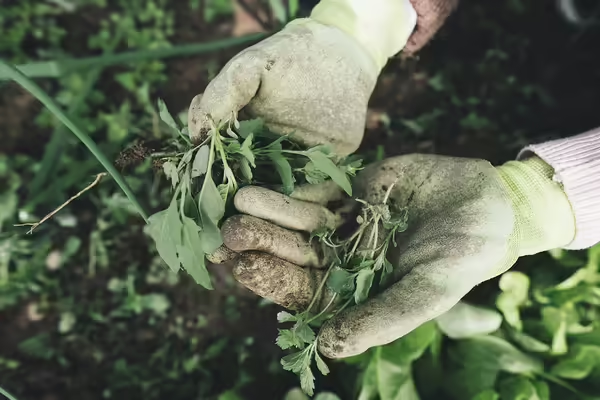
Winter is a good time to make garden plans, and one constant issue gardeners face every growing season is weeds. While weeds can be frustrating, they can also be saying more about a yard than you think.
Weeds can be found in a wide range of locations. Some weedy plants are more likely to be found in specific environmental conditions. These plants are sometimes called indicator species because their presence provides clues about the existing environmental conditions, such as soil compaction, acidic soil, excess moisture, dry soils, low light, and low fertility. While indicator plants can grow in other conditions, their presence might be a sign for you to investigate soil and environmental conditions.
There are two main strategies to reduce weed infestations. The first is ensuring the right plant is in the right conditions to thrive. The second is to amend the soil or conditions to create a less favorable environment for weed growth.
It is essential to identify weeds so they can be correctly controlled. Once the weed is identified, some research will provide information on its life cycle to help determine the best methods to discourage growth.
Low Fertility
Plants such as the common mullein (Verbascum thapsus), plantain (Plantago spp.), and white clover (Trifolium repens) can be indicators of low fertility. A soil test is an excellent way to verify this. Low-fertility soil can be modified by adding organic matter through cover crops, compost, or organic fertilizers such as bone or fish meal.
Another option is to select plants that thrive in low fertility conditions to out-compete the weeds.
Perennials
- Coreopsis (Coreopsis spp.)
- Globe thistle (Echinops ritro)
- Goldenrod, sweet (Solidago odora)
- Ornamental sage (Salvia spp.)
- Blanket flower (Gaillardia x grandiflora)
- Rattlesnake master (Eryngium yuccifolium)
- Yarrow (Achillea spp.)
Shrubs
- American filbert (Corylus americana)
- Fragrant sumac (Rhus aromatica ‘Gro-Low’)
- Ninebark (Physocarpus opulifolius)
Wet Soils
Certain weed species indicate excess moisture. Species such as annual bluegrass (Poa annua), common chickweed (Stellaria media), Pennsylvania smartweed (Polygonum pensylvanicum), and yellow nutsedge (Cyperus esculentus) hint at too much moisture in that area.
These areas can be a good spot to add native water-loving plants for a natural rain garden. Rain gardens give water a place to infiltrate the soil, which also cleans the water and reduces runoff. These plants thrive in wet conditions:
- Blue flag iris (Iris versicolor)
- Cardinal flower (Lobelia cardinalis)
- Dogwood (Swida spp.)
- Joe Pye weed (Eutrochium purpureum)
- River birch (Betula nigra)
- Pussy willow (Salix discolor)
- Swamp milkweed (Asclepias incarnata)
- White turtlehead (Chelone glabra)
Soils that dry quickly
Soils prone to drought do not retain as much water as other soils, creating a favorable environment for weedy species such as crabgrass (Digitaria spp.), plantain (Plantago spp.), prostrate knotweed (Polygonum aviculare), and woodsorrel (Oxalis stricta).
Improve soil health using soil-friendly garden practices and add organic matter to help the soil better hold onto water. Control erosion by leaving plants or mulch on the soil. Use soil tests to monitor soil fertility, paying close attention to potassium levels, which can be low in drought-prone soils.
Compacted Soils
Bindweed (Convolvulus arvensis), broadleaf plantain (Plantago major), chicory (Cichorium intybus), dandelion (Taraxacum officinale), and prostrate knotweed (Polygonum aviculare) can be indicators of soil compaction. Reduce compaction by adding organic matter, redirecting foot traffic, or core aerating the soil to make a less favorable environment for these species.
Plants can adapt to a range of conditions, and it is important to note that some species can thrive in more than one environment, so using weeds as indicators of conditions is just one way to read the hints a garden is giving. Use the clues to dig deeper and create a less favorable environment for weedy invaders. This approach is not foolproof, but it is a place to start to reduce weed infestations.
Nicole Flowers-Kimmerle is an Illinois Extension horticulture educator for Fulton, Mason, Peoria, and Tazewell counties. Gardeners Corner is a quarterly newsletter from gardening experts around the state. Each issue highlights best practices that will make your houseplants, landscape, or garden shine in any season. Join the Gardener’s Corner email list at go.illinois.edu/GCsubscribe for direct access to timely tips.
Photo caption: Weeds can hint at what is happening in the soil and environment. It is not 100% foolproof, but it is a place to start to reduce weed infestations. Photo credit: Image by AC works Co., Ltd. from Pixabay
Illinois Extension leads public outreach for University of Illinois by translating research into action plans that allow Illinois families, businesses, and community leaders to solve problems, make informed decisions, and adapt to changes and opportunities. Illinois Extension is part of the University of Illinois Urbana-Champaign College of Agricultural, Consumer and Environmental Sciences.